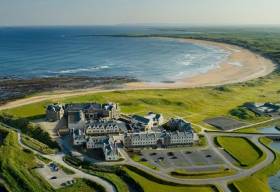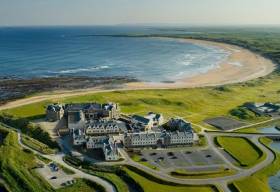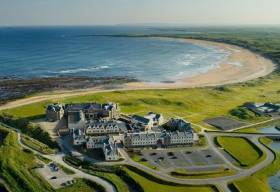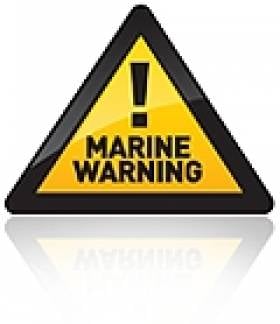Displaying items by tag: Doonbeg
#Doonbeg - Controversial proposals for coastal defence works at Donald Trump's Doonbeg golf resort have not been proved necessary, according to the Department of Arts, Heritage and the Gaeltacht.
As The Irish Times reports, the department's submission to Clare County Council makes note of the "complex mosaic" of Doonbeg's dune habitats, a Special Area of Conservation and home to a protected rare snail species, suggesting that any physical interference by way of a rock wall or 'berm' would result in shifting sands and other significant changes.
“The case has not been made to prove that the rates, patterns and causes of erosion at the site warrant the type and scale of the solution proposed," the submission adds.
Earlier this month Doonbeg residents came out overwhelmingly in favour of the coastal defence works, which Trump's representatives say are required for the continued operation of the resort the property tycoon and US presidential hopeful purchased in February 2014.
The 2.8km, 200,000-tonne rock barrier is opposed by various groups beyond the Co Clare village, including the local Save Doughmore Beach Protection Group. More on this story in The Irish Times.
Doonbeg Backs Coastal Defences At Trump Golf Resort
#Doonbeg - Doonbeg businesses and residents have come out in almost unanimous support for coastal defence works at Donald Trump's golf resort in the Co Clare village.
Two months ago the billionaire businessman and US presidential hopeful was stumped in efforts to bypass Clare County Council with plans for a 200,000-tonne, 2.8km rock wall to prevent coastal erosion alongside the links course he purchased in February 2014.
But as The Irish Times reports, Doonbeg says 'Yes' – as all but one of the local submissions to the council over the scheme give their backing to the embankment, which it's claimed would also protect local homeowners and farms from flooding.
Thirty-six of the 112 total submissions are opposed to the project. These include the Save Doughmore Beach Protection Group, a new association formed in the community north of Doonbeg, who say the rock wall will have a "negative effect for countless generations".
The Irish Times has more on the story HERE.
Planners Stump Trump Over Doonbeg Coastal Defences
#Doonbeg - Donald Trump may be topping Republican Party polls on the road to The White House, but the billionaire businessman has hit a stumbling block in proposals for his Doonbeg golf resort, as The Irish Times reports.
An Bord Pleanála has ruled that plans for a 200,000-tonne, 2.8km coastal embankment adjacent to the links course Trump purchased in February 2014 do not constitute a 'strategic infrastructure development', or SID, which would have allowed the scheme to bypass Clare County Council.
Now the plans – declared as protection against coastal erosion – must be resubmitted to the council for a decision whose outcome "will determine the future of our business, the local community and its citizens", according to the resort's general manager Joe Russell.
The application is expected to face opposition from environmentalists mindful of the area's protected species such as the narrow-mouth whorl snail, a tiny mollusc at the centre of controversy over unauthorised coastal defence works on the shoreline two years ago.
The Irish Times has more on the story HERE.
Trump Trumpets Jobs On Visit To Clare Golf Links
#CoastalNotes - Billionaire businessman Donald Trump has arrived in Ireland amid much pomp and circumstance, promising "hundreds" of jobs in Co Clare, according to TheJournal.ie.
As previously reported on Afloat.ie, Trump purchased the former Doonbeg Lodge and Golf Club on the Clare coast for a bargain €15 million after it went into receivership in January during the extraordinary stormy winter.
Subsequently the US Apprentice host became embroiled in a brouhaha over the fate of an endangered snail species that lives on the property, after he sent in lorry-loads of rock armour to shore up coastal defences without the requisite planning permission.
This morning (Monday 12 May) Trump arrived at Shannon Airport to a red carpet welcome, complete with a harpist, fiddle player and singer to play his alighting from his personal branded aircraft, before meeting Finance Minister Michael Noonan and local dignitaries.
On the agenda for the next three days will be Trump's ambitious plans for the golf resort, including the addition of a "truly great ballroom" that would "generate a lot of jobs".
He also pledged to work with environmentalists over the habitat of the narrow-mouth whorl snail - though dismissed claims that the tiny mollusc was unique to Doonbeg.
TheJournal.ie has much more on the story HERE.
Trump Plants Flag In Ireland With Clare Golf Links Purchase
#CoastalNotes - Billionaire businessman Donald Trump is the new owner of the Doonbeg Lodge and Golf Club on the Clare coast, as RTÉ News reports.
The €15 million purchase - snapped up after it went into receivership last month - will see the coastal golfing resort renamed Trump International Golf Links, Ireland as it joins the fold of The Apprentice host's international property portfolio.
"Doonbeg is an already terrific property that we will make even better," said Trump in a statement. "It will be soon be an unparalleled resort destination with the highest standards of luxury."
Marine Notice: Rock Placements Off Co Dublin & Buoy Deployments Off West Cast
#MARINE WARNING - The latest Marine Notices from the Department of Transport, Tourism and Sport (DTTAS) advise mariners to keep a look-out for rock placement off north Co Dublin and buoy placements off Co Mayo and Co Clare.
Operations were due to commence on Saturday 8 September at North Beach in Rush, Co Dublin for the placement of rocks offshore and in the Irish Sea for a period of 10-12 days weather permitting.
The works are being undertaken by DPFPV Tideway Rollingstone (call sign PHYR) and DPFPV Stornes (call sign PCKX) at various locations detailed in Marine Notice No 49 of 2012, a PDF of which is available to read or download HERE.
These vessels are operating on a 24-hour basis and will display appropriate days shapes and lights. They are also transmitting an AIS signal and will keep a listening watch on VHF Channel 16 for the duration of the works, which involve the deployment of survey ROVs and fall pipe that will restrict the vessels' movements. All mariners are instructed to give a wide berth.
Meanwhile off the west coast, ESB International has deployed two Waveroder buoys as positions near Achill Island in Co Mayo and Doonbeg in Co Clare.
The Achill buoy will be operational for a minumum of three months from now, while the Killard buoy will be operational for a minimum of 10 months having been recently relocated. Both are spherical and yellow in colour. All vessels are requested to give the buoys a wide berth.
Full details of their positions are included in Marine Notice No 50 of 2012, a PDF of which is available to read or download HERE.



































































